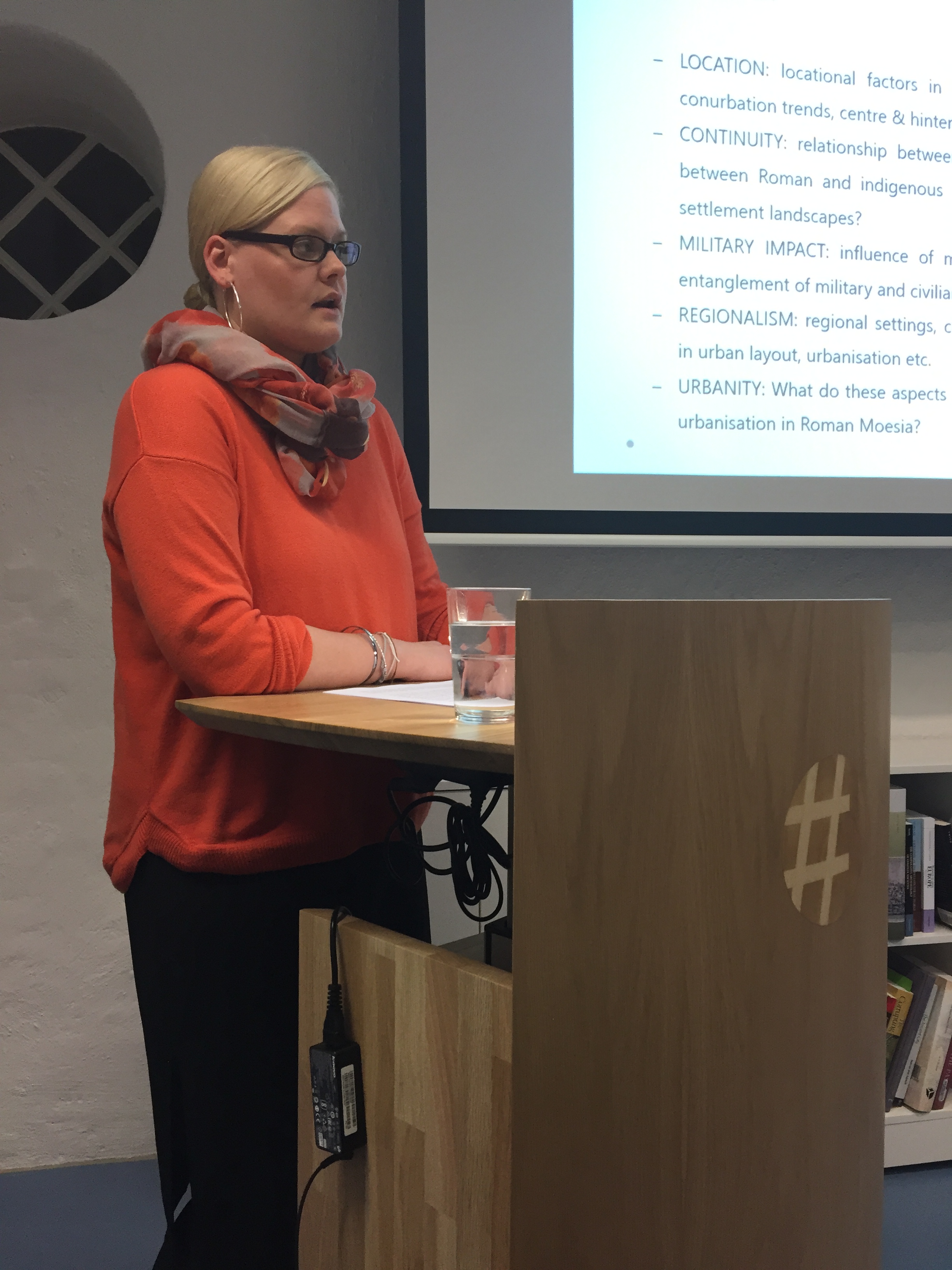Research stay at UrbNet 2016
by former Visiting PhD student Lina Diers (Universität Wien).

Being based at the Institute for Classical Archaeology at the University of Vienna, Austria, I am currently working on my dissertation project with the preliminary title The Roman province of Moesia: Comparative studies on the formation of urban spaces in Moesia Superior and Inferior in the first three centuries AD. In the time from the 9th of September until the 12th of December 2016, I stayed at the Centre for Urban Network Evolutions based at Aarhus University on the Moesgaard Campus as a visiting PhD student. The idea to apply for a visiting PhD student grant provided by Aarhus University Research Foundation (AUFF) evolved earlier in 2016 due to the extraordinarily well-fitting connection of the research centre’s scientific focus, research orientation and project outline and my own research.
In my PhD project, I am investigating urban or possibly urban Roman settlements in the provinces of Moesia Superior and Inferior covering parts of the modern states of Serbia, Bulgaria, Romania, Macedonia and Kosovo. Defining urbanity and urbanisation processes in this region of the Roman Empire during the Principate is no easy task, since the characterisation of settlements is very determined both by the state of sites and research and traditional conceptions of urbanity in the Roman World in terms of structural, political and organisational factors. Thus, my research is geared towards rethinking urbanity and urbanisation in Moesia as social and economic dynamics, providing the first comparative analysis of Roman settlements in the whole of Moesia and also possible reference points for the remaining Empire. To accomplish this major aim, I am investigating 26 Roman settlements in the two province parts of Moesia in terms of locational factors in landscape, military and economy, settlement development and continuity from pre-Roman to Roman times and throughout the Principate, military impact on urban evolutions and scale on different levels. In doing so, I am applying a regional model on Moesia in order to acknowledge and test the existence, character and impact of network dynamics, interregional connections and supra-regional differences. Thus, I found the mission statement of UrbNet definitely related to my research – especially on a theoretical level – and expected a great outcome of being affiliated with the centre for a while.
During my whole stay in Aarhus, I was based at the Centre for Urban Network Evolutions at Moesgaard, sharing the office space with the employees on PhD and Postdoc level and participating in the daily routine of the Centre. This included taking part in weekly lecture series, the internal UrbNet meetings, a journal club organised especially for UrbNet employees and specific questions, a conference on urbanity in medieval Scandinavia organised by some of the UrbNet members and a PhD course on contextual archaeology. Apart from that, I was also able to participate in various lectures and events organised by the Department of Archaeology, School of Culture and Society, at Aarhus University and the Museum of Antiquities. Giving one lecture on my own research and also actively participating in the ‘Centre Day’, a detailed presentation of all projects affiliated with UrbNet, gave me the possibility to incorporate my research into the Centre as well. Apart from these activities, I met brilliant circumstances to work on my dissertation, which lead to finishing some case studies and general chapters of the written study. Here, the continuous, detailed and dense supervision of the Centre directors has been very helpful and inspiring.
The brilliant infrastructure and working environment at the Centre for Urban Network Evolutions made my stay in Aarhus and the daily working routine very convenient and motivating. In addition, the informal and cooperative atmosphere at the Centre lead to vibrant discussions concerning various research projects – including mine, lectures, publications and the situation of urbanism studies and urban archaeology in general, which really made me profit a lot. Especially the interregional approach of UrbNet, connecting various areas and time frames of the ancient world, has been very inspiring for me. Being introduced to study regions and topics I haven’t been working on so far (e.g. medieval Scandinavia or East Africa) and noticing that though questions, investigation methods and results might differ the approach to urbanism and the theoretical base of research are often the same has been absolutely helpful for strengthening my scientific profile and consolidating the approach to my PhD project.
Generally speaking, the whole stay at Aarhus and the Centre for Urban Network Evolutions has been really inspiring to me and helped taking my PhD research to the next level, which is why I would highly recommend considering an application as a visiting PhD student at UrbNet to any PhD student working on urbanism studies in the broadest sense and interested in international experience on a high scientific level.
